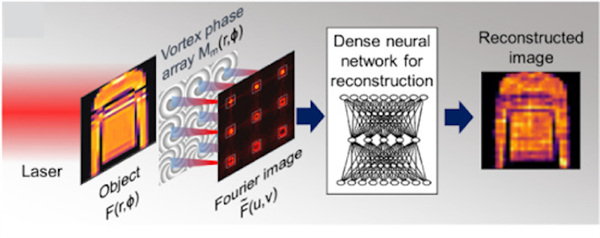Real-Time Imaging in Low Light Conditions
Full Description
Background
Imaging under low-light conditions has been challenged by a tradeoff between capturing sufficient signals and managing noise. Conventional approaches rely on iterative processing of deep, complex neural networks that struggle with speed and generalization. Conventional Fourier-based and random spatial encoding approaches often struggle with issues such as ghosting, blurring and accurate recovery of phase information. Moreover, these methods face limitations in edge detection and resolution enhancement, making them less effective for real-time applications. Achieving improved signal-to-noise ratios, fast processing speeds and robustness across varied imaging conditions remains a critical challenge.
Technology
Prof. Luat Vuong and her team at UCR have introduced a novel, multi-lens imaging system that uses a vortex lenslet array enabling low-light, high-speed imaging by capturing both real and imaginary image components. Unlike conventional methods, this system uses a compact, shallow neural network to efficiently and robustly reconstruct images from intensity-only data. The integration of polyaniline inverse opal films for spectral and polarization filtering broadens the technique's multimodal imaging capabilities. This hybrid optical-digital approach achieves high-speed, low-power and memory-efficient imaging with generalizability to unseen object classes.

General schematic of the technique: a laser illuminates the object. Transmitted light is phase modulated with a multivortex lens array. The back focal plan vortex Fourier intensity are fed to a neural net that reconstructs the original image.
Advantages
- Low size, weight and power (SWaP) for low-light conditions
- Low computational complexity and low latency
- Enables fast, non-iterative, single-shot image reconstruction with a compact neural network
- PANI-IOF is more versatile than any linear grating due to its radially, symmetric geometry
- Allows multimodal imaging capabilities through potential integration with spectral and polarization filtering materials
Application
- Low-light imaging
- Driver assistance systems
- Vision system for applications such as fire fighting
Lead Inventor
- Please review all inventions by Luat and her team at UCR
- Please visit Luat's group website to learn more about their research
- Please read recent press coverage of Luat at UCR
Related Materials
Patent Status
| Country | Type | Number | Dated | Case |
| United States Of America | Issued Patent | 12,298,524 | 05/13/2025 | 2020-236 |
Contact
- Venkata S. Krishnamurty
- venkata.krishnamurty@ucr.edu
- tel: View Phone Number.
Other Information
Keywords
Low light imaging, low signal-to-noise, night vision, neural networks, tissue imaging
